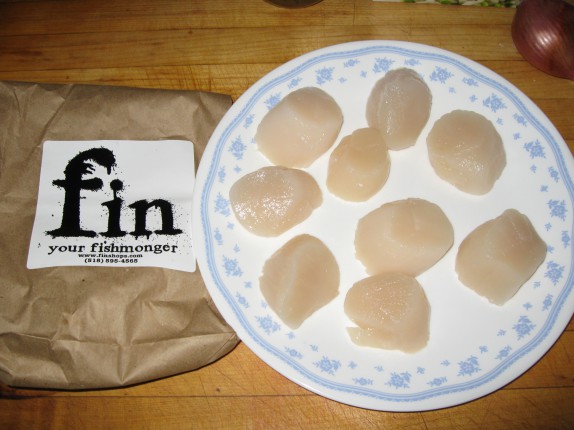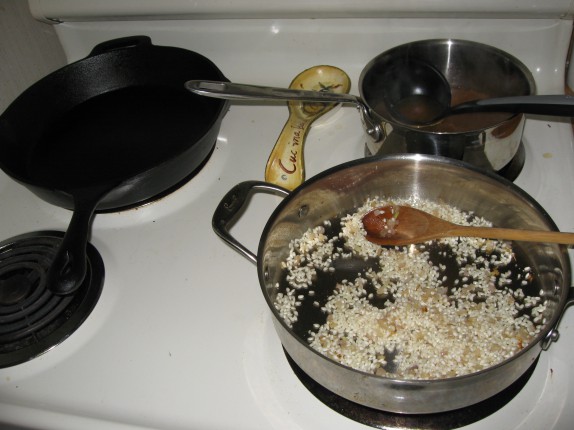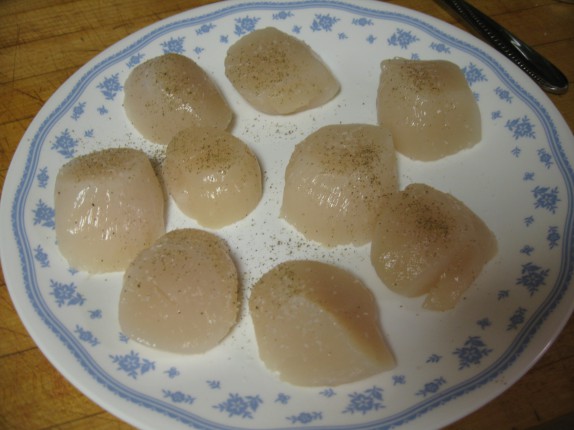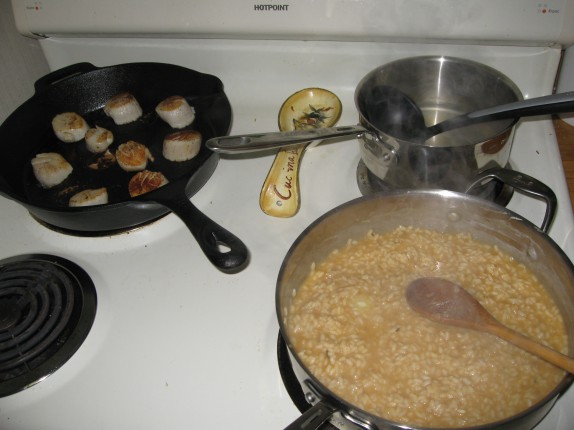derryX cooks: Scallops
I don’t know why, but I had a strange temptation to buy scallops from Fin: Your Fishmonger. I’ve never ordered scallops in a restaurant nor have I ever tried cooking them. For some reason, the idea of searing off some scallops, bathing them in some of my homemade pesto and serving that over risotto sounded good for dinner one night.
The trick was timing because risotto needs to be served immediately when it’s done, and scallops take a very short time to cook. However, starting the scallops as the risotto was finished would mean the risotto would be dying as the scallops were cooking.
I overlapped the preps just a little. Naturally, I started the risotto first.
I’ve gone over the technique to cooking risotto before, but here’s a (slightly modified) primer:
To make the risotto, you’re going to have to commit to standing in front of the stove stirring for about 20 minutes. In a saute pan, I started with about 2 tablespoons of olive oil, a nicely sized, finely diced shallot, and some salt. I cooked the shallot over medium heat until soft. Then, I added enough rice to cover the bottom of the pan (It probably took me a cup and a half to two cups). I toasted the rice in the oil and shallot for a couple of minutes. Addition of liquids (white wine followed by warm broth) should commence when the rice is nice and hot. I continually stirred the mixture. As the rice absorbed all of the liquid, I made subsequent liquid additions (about 1/2 cup at a time) from the broth I had heating on the back burner. Each time, as the rice absorbed the liquid, I added more. When the rice looked almost cooked and the rice had absorbed most of the liquid, I tasted it. I was looking for the rice to be aldente (meaning there would be a little part of the center of the grain still tough). I was also looking to adjust the salt level. At this point, I added a little more liquid. This is the part people mess up. Since you’re going to add things that are going to tighten up the risotto, you want more liquid than the rice can hold at this point. Then, I added my grated cheese, a few knobs of butter, some olive oil, and served it immediately.
I lightly dusted the scallops with kosher salt and fine ground black pepper.
I started the scallops in a screaming hot cast iron skillet once the risotto was almost done.
The scallops should get a nice color on the first side in a few minutes before they get flipped.
When they were done, while they were warm, I tossed them in a little bit of the pesto (which I had preserved by freezing). To finish the risotto, I cut back on the cheese a little since the pesto had some cheese in it; I didn’t want everything overpowering the scallops. This resulted in a risotto that didn’t flow quite as much as I like it to. It also required a little more salt to finish it.
The scallops I got from Fin were phenomenal. They were freshly delivered and had obviously never been frozen (you can usually tell when scallops have been frozen; their texture changes dramatically). The risotto was a fairly blank medium for the flavors of the scallops and pesto to shine through. I’m glad I didn’t overdo it with the pesto because I could definitely see how the basil could overpower the delicate scallops.
Good stuff!







Advertisement